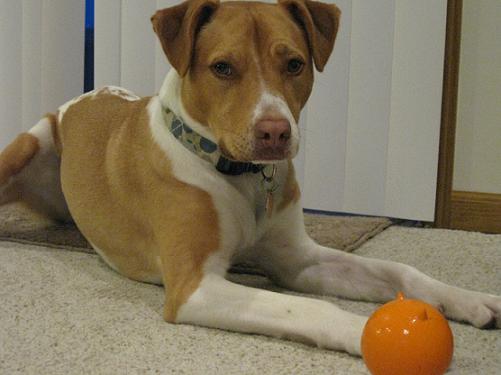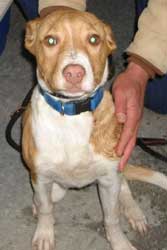I decided I’m ready to foster a dog again. More accurately, Josh didn’t say no this time when I showed him a photo of a petite “lab mix” described as “friendly with all.”
She must be cat friendly, I said.
We agreed to take Sammi next Monday. She needs to be transported to Fargo from an out of town shelter. She might even be adopted or taken in by a closer foster home before she gets to us. That would be great. If not, we at least have a few days to mentally prepare for another dog in the house.

There is never a perfect time to foster a dog. So if you are thinking that life is just too busy, too stressful or too tight right now, then tell yourself that fostering is only temporary. If you put some work into it, that dog might get adopted faster than you think.
I have high hopes that a cute, friendly, small mix like Sammi will get a home fairly quickly. If I were looking to adopt a dog right now, I would be considering her.
Update: Sammi was adopted!
Are you ready to foster a dog?
If you are considering fostering a dog, here are some ways to prepare for that dog’s arrival and what to do during those first few days:
1. Realize that little information is known about the dog.
Someone has given up on each shelter or rescue dog for a reason. Usually that reason is related to the dog’s high energy, housebreaking issues or “separation anxiety.” Your job as a foster home will be to get to know the dog’s real personality and help place her in the best home possible.
People working at the pounds, shelters and rescues will do their best to tell you about the dog. Keep in mind that “friendly” probably means hyper.
“Loves people” could mean “separation anxiety” issues. “Seems OK with other dogs” means someone wasn’t comfortable saying “Good with other dogs.”
By living with this dog, you will learn important sides of her personality and behavior. You will learn whether or not she is food aggressive, what toys she likes best, if she likes to cuddle, if she’s good in the car, if she is nice around cats and children and so much more.
2. Exercise your dog before the foster dog arrives.
If your own dog has had a long walk (1-2 hours) the morning before the foster dog arrives, he will be less excited and less anxious when he meets the new dog.
I always walk Ace for a good hour before we get a foster dog. The calmer he is, the calmer the new dog will be.
When dogs meet one another with lower energy, they are less likely to get defensive, fight or get too wild with their playing. If your dog has any aggressive tendencies towards other dogs at all, then walking him is even more important.
Try walking him with a dog backpack to help get rid of extra energy.
3. Walk the foster dog.
Even more important than walking your own dog is to walk the foster dog. The moment you get the dog home, take her out for an hour or two-hour walk.
Do this before you even bring her inside. Now that it’s warmer out, there is no excuse not to do this.
Rescue dogs are almost always full of pent-up energy and nervousness from living in a shelter for sometimes months before getting into a foster home. Walking her that first day and every day after that will help calm her.
Walking the foster dog right away will make the adjustment process smoother for everyone. She will see you as a leader and someone she can trust.
The walk will help her relax as she gets to know you and her new environment. Make sure she is wearing a well-fitted collar so there is no chance she could slip out.
You may want to even clip her leash to a harness and her collar just to be safe.
4. Walk the dogs together when they meet.
Dogs do not like to meet head on, but that is usually how people introduce two new dogs.
This could lead to a fight because dogs don’t like eye contact or confrontation.
If you walk the two dogs together right away with one on each side of you (or with a friend), this will allow them to get to know one another while they take a following role behind you. Instead of allowing them to play or fight, keep moving forward. Correct either dog if it gets too excited.
I’m not talking about jerking on the leash. Just a firm, “Hey” or “No” will do. After a long walk, the dogs may be able to play with fewer problems.
Make sure you don’t let the dogs take control and pull you or walk in front of you. You want to set yourself up as the leader right away. The last dog I fostered was much more dominant than my dog.
The best way to put her in a following role was to walk the two dogs together. This put them in a pack mentality because they were working side by side.
5. Bring home the foster dog on a day you don’t work.
By taking in the foster dog on a day you are home, you can help her adjust before leaving her alone for eight hours. You want enough time available for at least one long walk on that first day. Walking the foster dog will be important every day, but especially the first two or three days. Do what you can to take in the foster dog on a weekend.
I made the mistake of getting a foster dog on a day I had to work. I did not know she had severe separation anxiety issues until I came home on my lunch break. The dog had busted out of her kennel and had started to tear apart my door frame. I could have prevented this by getting her on a day I did not have to work. I would’ve gotten to know her better before leaving her home alone.
6. Begin leaving the dog alone right away.
Right after walking the foster dog, leave her alone in a quiet room or a kennel for a half-hour with something good to chew. This will help her realize she is going to be left alone from time to time and everything will be OK. You don’t have to actually leave the house. Just get the dog used to some quiet, “down time.”
If she is quiet, return to her after a half-hour and let her out. Don’t give her any praise when you return. Instead, act like it was no big deal. You don’t want to make a big deal out of you returning. That will only add excitement, anxiety and nervousness. She needs to be OK with you coming and going. Neither of these actions should ever be a big event.
7. Use a kennel.
You can’t be sure the foster dog is housebroken. Leaving the dog in a kennel will keep her from going to the bathroom on the floor when you are gone. It will also give you some peace of mind because you know the dog will not be chewing your walls or digging into your carpet. She will also not be able to hurt herself.
8. Let the foster dog outside often.
Even housetrained dogs will have accidents if they are in a new environment, especially if they are nervous or excited. Don’t get upset if this happens. Take the dog out every time she wakes up, gets out of her kennel or after she eats. You will find out really fast how reliable she is with going to the bathroom outside. If your dog does have an accident, steam carpet cleaners work really well for getting out stains. Our grocery stores rent them out for about $20 a day.
9. Be patient.
Every foster dog will come with issues of some sort. What dog doesn’t have issues? Ace certainly does. My dog barks at the door, he has a tennis ball obsession and my dog is always hungry.
Remember that the foster dog has been through a lot. You are doing a great thing by helping her.
10. You don’t have to keep the dog.
If the dog is really that bad – barking all day, peeing everywhere, attacking your cat – you can always return the foster dog to the rescue. There’s nothing wrong with trying and realizing you’re not up for fostering that particular dog. Most people don’t even try.
11. Start finding that dog a home!
Why do you think I’ve started blogging about fostering before I even have a foster dog? The more information I get out about the dog, the faster she will get a home! So do what you can: Take the dog to the dog park and tell everyone she’s up for adoption. Take her to pet-friendly stores. Dress her in cute bandannas and T-shirts to get attention. Make fliers. Go to adoption events.
What are some other ways to prepare for a foster dog?


Chrissy
Monday 8th of April 2013
I am the animal co-coordinator for a small foster in Saskatchewan, Canada. I have copied your info on this page to attach it to out foster agreement we have made up. You have taken a lot of time and effort writing that out and have covered everything. I hope you are ok with me doing this if not please let me knkow. Thank you so much. You really know your stuff and it is really helpfull to have information like this to give to fosters.
Lindsay Stordahl
Monday 8th of April 2013
Of course you can share it and print it out for your foster agreement. If you could give credit to ThatMutt.com, that would be appreciated. Hopefully your foster homes will visit the site for more useful tips. Thanks for reading, and thanks for all you do for the dogs!
Abbey
Wednesday 18th of March 2009
What a cutie Lindsay, good on you for giving her a go and some great, well thought out tips...x
megscole64
Wednesday 18th of March 2009
When we brought home our foster, and then our Timber Wold, we kept the three "main" dogs out in the back yard and let the new dog in the house. That way, they are already in the 'home' zone of the dogs and the new dog is with "mom" ... I keep the screen door closed so they can sniff each other through the door. If there isn't too much trauma I let the other dogs in ... trying to let only one in at a time (which can be a challenge when they all want in).
My fear was the Three dogs being territorial and aggressive but they were all three wonderful with our foster dog and when we brought home Timber. I think having a well socialized dog helps a lot. :)
I'm not cut out to be a foster mom though. I wanted to keep our first (and only) foster dog the first day we brought her home. :)
Kari
Wednesday 18th of March 2009
Good for you!! Keep us posted on how it goes! :)
Apryl DeLancey
Wednesday 18th of March 2009
Oh, she is soooo sweet looking! I haven't been able to do this myself. Good luck!